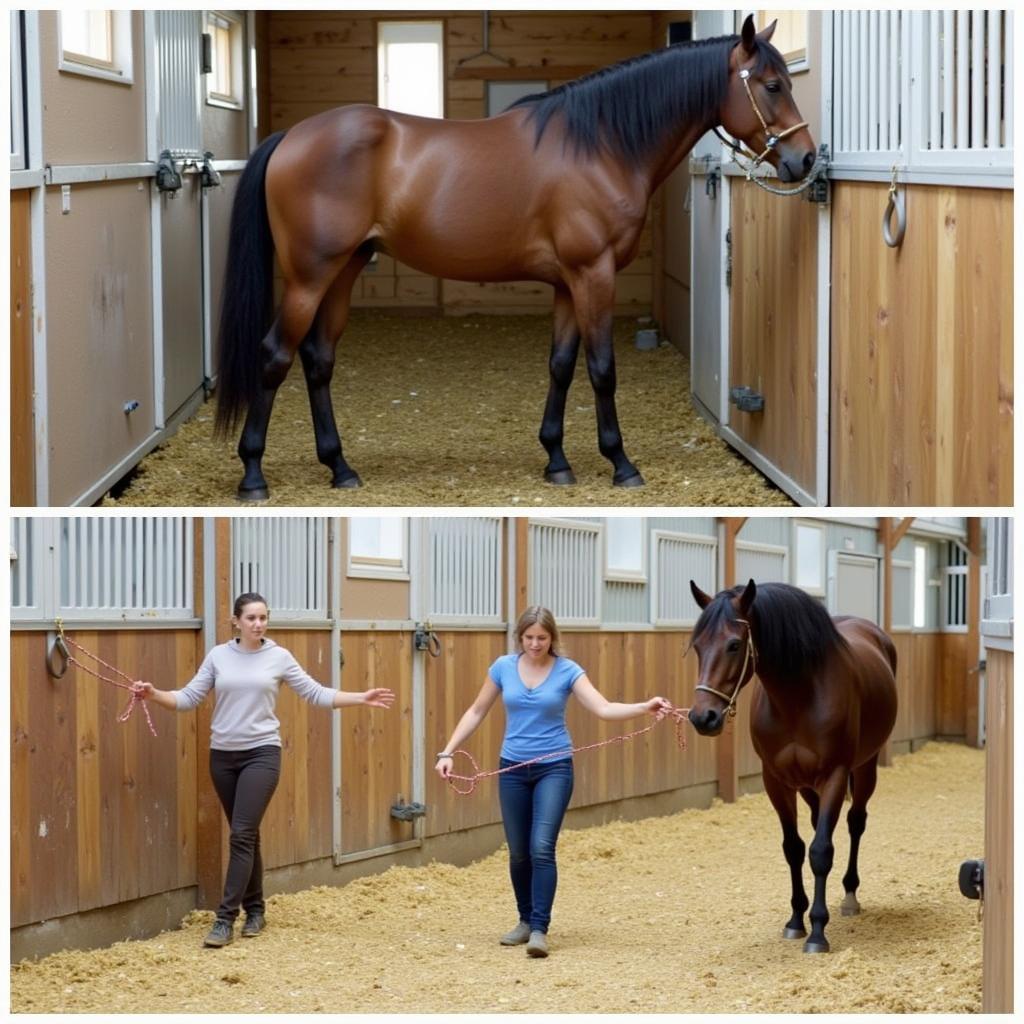Horse Tie Downs are a common piece of equipment used in various equestrian disciplines, from showing to training. They provide a point of control and can help prevent a horse from rearing or pulling back. However, their use can be controversial and requires careful consideration to ensure both safety and effectiveness. This article will delve into the complexities of horse tie downs, exploring their different types, appropriate usage, and potential risks.
Choosing the Right Horse Tie Down
Selecting the appropriate tie down depends on several factors, including the horse’s temperament, the activity being performed, and the handler’s experience. There are various types available, each with its own advantages and disadvantages. Quick-release tie downs are favored for their safety features, allowing for quick detachment in emergencies. Nylon tie downs are lightweight and durable, while leather tie downs offer a more traditional and often more adjustable fit. It’s crucial to choose a tie down that is the correct length and properly adjusted to avoid discomfort or injury to the horse.
What are the different types of horse tie downs? Quick-release, nylon, and leather are the most common.
Safe and Effective Use of Horse Tie Downs
While tie downs can be helpful tools, improper use can lead to serious problems. They should never be used as a punishment or a substitute for proper training. Over-tightening a tie down can restrict the horse’s breathing and cause undue stress. It’s essential to tie the horse to a secure object that won’t break or give way. Regularly check the tie down for wear and tear and replace it if necessary.
Is clover bad for horses? Find out more about horse-friendly forage. is clover bad for horses
Why is proper adjustment of horse tie downs so important? It prevents discomfort, stress, and potential injury to the horse.
Potential Risks and Alternatives to Tie Downs
Despite their benefits, tie downs do carry potential risks. If a horse panics while tied, it can injure itself struggling against the restraint. Improperly adjusted or poorly maintained tie downs can also cause rubs, sores, and even more severe injuries. In some situations, alternatives to tie downs, such as cross-ties or ground tying, may be more suitable. These methods can offer control without the same level of restriction.
Dr. Emily Carter, DVM, Equine Specialist, emphasizes, “Tie downs should be used judiciously and with a clear understanding of their potential impact on the horse’s well-being. Proper training and handling techniques often minimize the need for such restraints.”
 Alternatives to Horse Tie Downs
Alternatives to Horse Tie Downs
What are some alternatives to horse tie downs? Cross-ties and ground tying can be effective and less restrictive.
Looking for horse trailer rentals? Check out options near you. horse trailer rent near me
When to Consult a Professional
If you are unsure about using horse tie downs, it’s always best to consult with a qualified equine professional. A trainer or veterinarian can assess your horse’s temperament and advise on the most appropriate methods of restraint for your specific needs. They can also help you learn how to use tie downs safely and effectively.
John Miller, Certified Horse Trainer, adds, “Choosing the right tie down and learning how to use it correctly is crucial for both horse and handler safety. Don’t hesitate to seek expert advice if you have any concerns.”
In conclusion, horse tie downs can be valuable tools when used responsibly. However, their use requires careful consideration of the horse’s well-being and a thorough understanding of safe handling practices. By prioritizing proper training, appropriate equipment, and expert guidance, we can ensure the safety and comfort of our equine partners.
Have you heard any good horse betting jokes lately? Share a laugh with our collection. horse betting jokes
FAQ
-
Are horse tie downs cruel? Tie downs themselves are not inherently cruel, but improper use can cause distress and injury.
-
What are horse tie downs used for? They provide control and prevent rearing or pulling back.
-
What type of tie down is safest? Quick-release tie downs are generally considered safest.
-
Can I leave my horse tied down unattended? No, never leave a tied horse unattended.
-
How tight should a tie down be? It should allow for comfortable head movement and breathing.
-
What are the alternatives to tie downs? Cross-ties and ground tying are common alternatives.
-
When should I consult a professional about tie downs? If you’re unsure about proper usage or have concerns about your horse’s behavior.
Interested in famous horse racing tracks? Explore our guide. famous horse racing tracks
Need horse removal services? Find providers in your area. horse removal services near me
For assistance, contact us at Phone Number: 0772127271, Email: [email protected] Or visit us at: QGM2+WX2, Vị Trung, Vị Thuỷ, Hậu Giang, Việt Nam. We have a 24/7 customer service team.